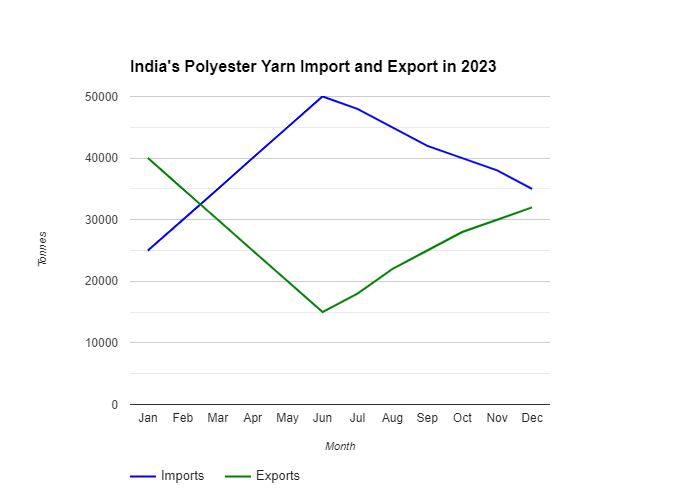Indian polyester trade swings from export boom to import tide in 2023.
India's polyester yarn industry, once a thriving exporter, has undergone a reversal of fortunes. In FY23, imports grew almost 65 per cent, while exports went down 38 per cent, pushing India into the uncomfortable position of a net importer for the first time in a decade. What’s more, this concerning trend continues into the first eight months of FY24, raising critical questions about policy, demand, and supply dynamics.
Cheap Chinese imports a disrupter
Analysts attribute this upheaval to a confluence of factors. The influx of cheap imports, primarily from China, has flooded the domestic market, putting immense pressure on Indian manufacturers' pricing power. Driven by its stringent zero-COVID policy, China's domestic textile consumption slumped, leading to a massive surplus production of polyester yarn. This surplus found its way into the Indian market at significantly lower prices, undercutting Indian manufacturers and wreaking havoc on their profitability.
Between FY22 and FY23, India's polyester yarn imports witnessed a staggering 65 per cent increase, while exports nosedived by 38 per cent, as per CareEdge Ratings. This drastic shift transformed India from a net yarn exporter to a importer. “The Chinese are dumping yarn at unbelievably low prices," says Rajesh Agarwal, President of the Synthetic & Rayon Mills' Association of India (SRMAI). "It's become impossible for us to compete on cost alone." Agrees Suresh Kumar, President of the Indian Textile Manufacturers' Association, "The influx of cheap Chinese imports has had a devastating impact on the Indian polyester yarn industry," he says highlighting the gravity of the situation.
This import surge has sent Indian yarn producers in a flux. Their profit margins have been squeezed, with the operating profits of the industry witnessing a significant decline in FY23 compared to the previous two years. This decline, primarily driven by competition from cheaper imports, has led to a contraction in export volumes and, in some cases, even plant closures and job losses.
Compounding the problem are rising domestic production costs, driven by factors like high energy prices and volatile raw material costs. This cost squeeze further erodes the competitiveness of Indian yarn in the global market.
Mixed bag of policies

The policy landscape also plays a role. The imposition of anti-dumping duties on Vietnamese yarn, while intended to protect the domestic industry, inadvertently created an opening for Chinese imports to fill the void. Additionally, the recent free trade agreement with the United Arab Emirates (UAE) has further tilted the scales in favor of cheaper imports. In fact, recognizing the distress of the domestic industry, the Indian government has taken steps to address the import challenge. These measures include:
Imposition of anti-dumping duties: The government has levied anti-dumping duties on specific types of polyester yarn imported from China. This move aims to level the playing field for Indian manufacturers and curb unfair competition.
Quality Control Order (QCO): The Bureau of Indian Standards (BIS) implemented a QCO on polyester yarn in October 2023. This was intended to curb import of substandard yarn and protect domestic consumers. However, delayed implementation initially disrupted the market and led to an increase in imports before the deadline.
While the long-term impact of the QCO is expected to be positive, its initial rollout wasn't without hiccups. The delayed implementation led to pre-buying by businesses in September 2023, followed by a significant decline in imports in November 2023. This volatility underscores the need for smoother policy execution.
Future Outlook: Uncertain but hopeful
"The outlook for the industry is uncertain, but there are some positive signs," highlights CareEdge Ratings in a recent report, emphasizing the need for both cautious optimism and proactive measures. While government's policy interventions offer a glimmer of hope, the continued influx of cheap Chinese imports and the lingering global economic slowdown pose significant challenges. However, there are also reasons for optimism. The expected demand revival in key markets like China, US and Europe could provide some relief, and Indian manufacturers who invest in technological upgrades and improve their competitiveness could stand to benefit.
India's polyester yarn industry stands at a crossroads. The government's support and the industry's own efforts to adapt and innovate will be crucial in determining its future trajectory. If these challenges are addressed effectively, the industry can reclaim its lost glory and regain its position as a leading player in the global textile market.
Statistics
- Indian polyester yarn industry is estimated to be worth over $15 billion
- India is the world's second-largest producer of polyester yarn, after China.
- The textile and apparel industry employs over 45 million people in India, making it a vital contributor to the economy.
